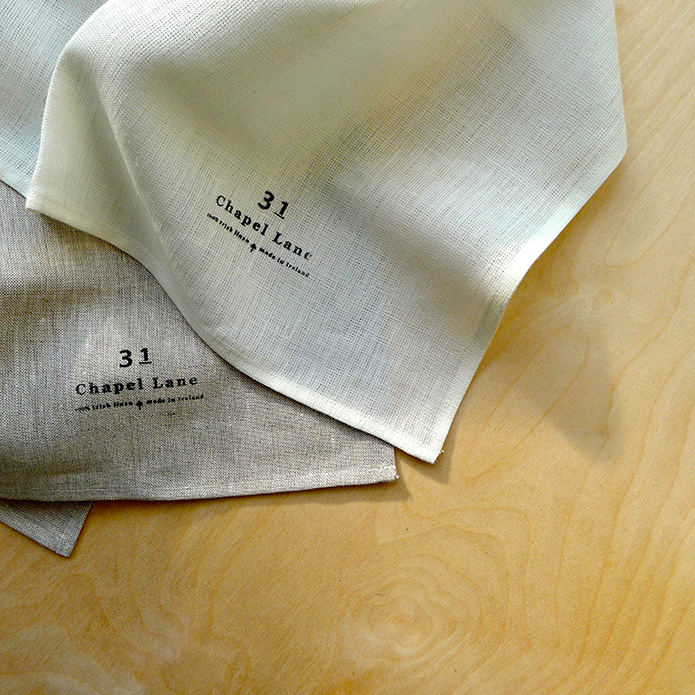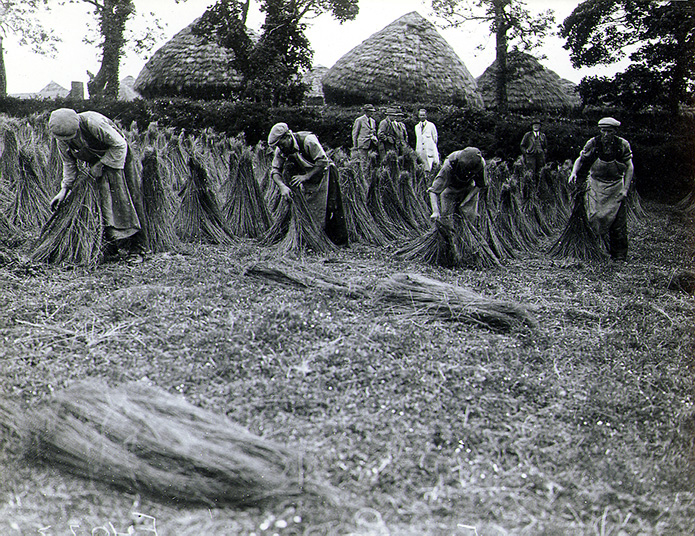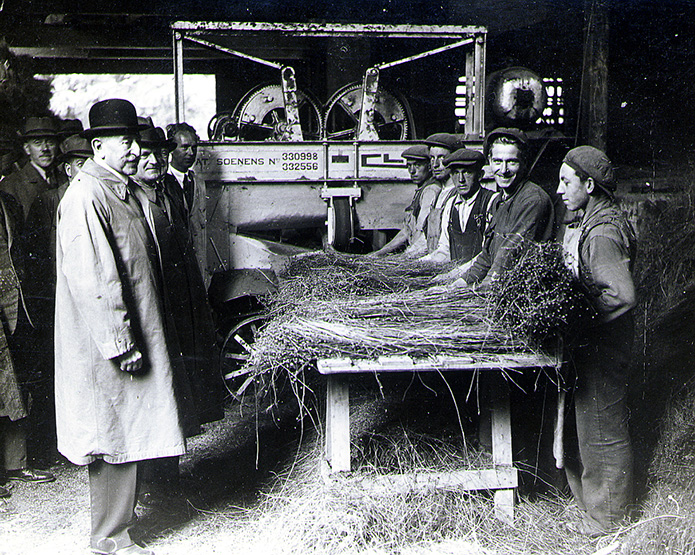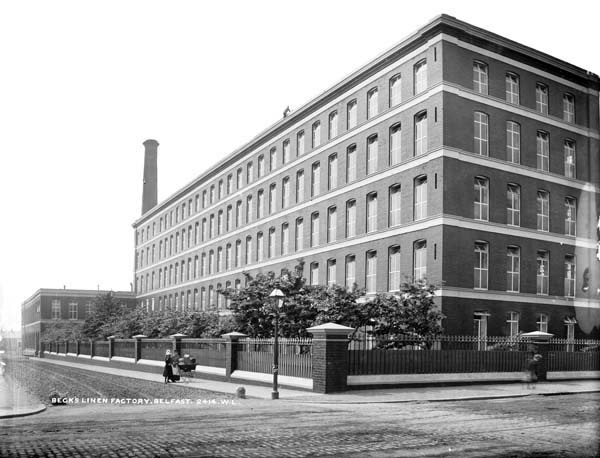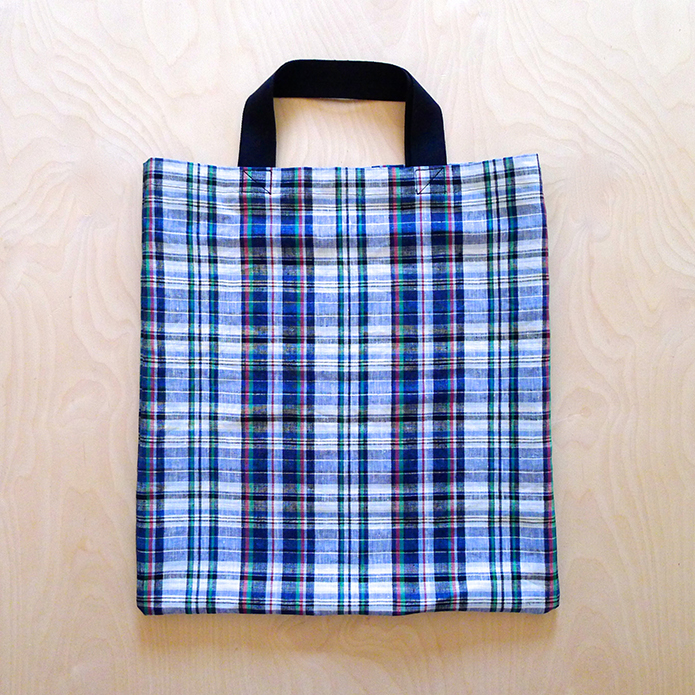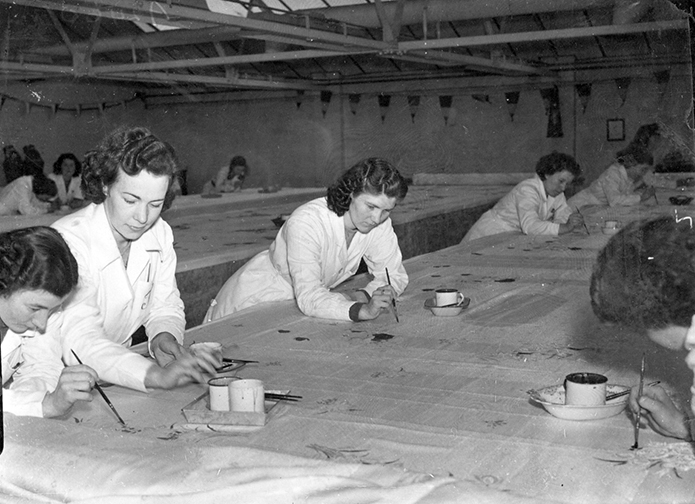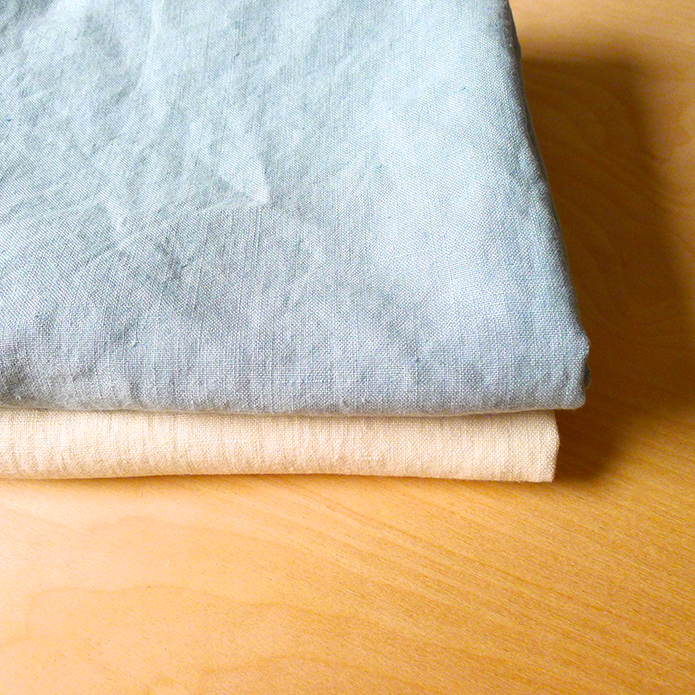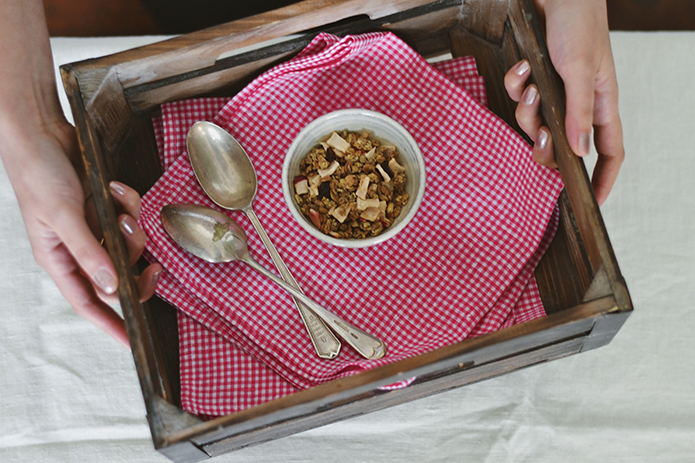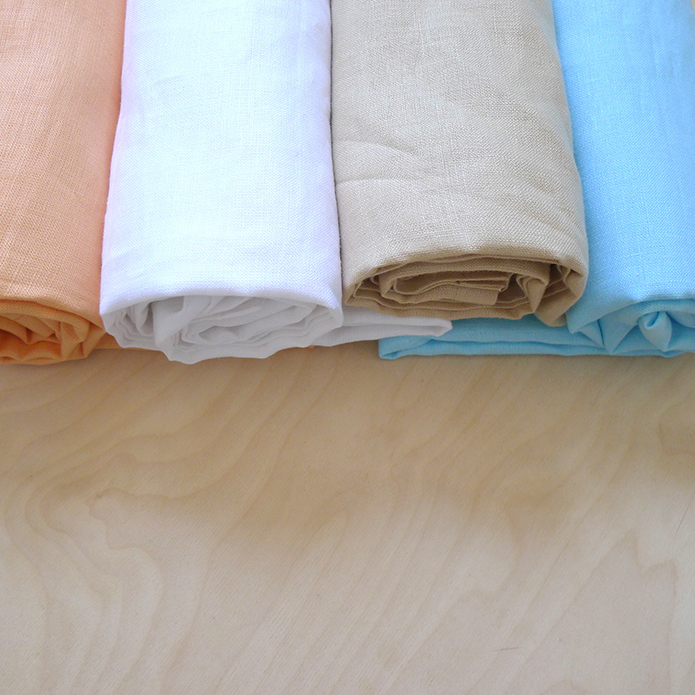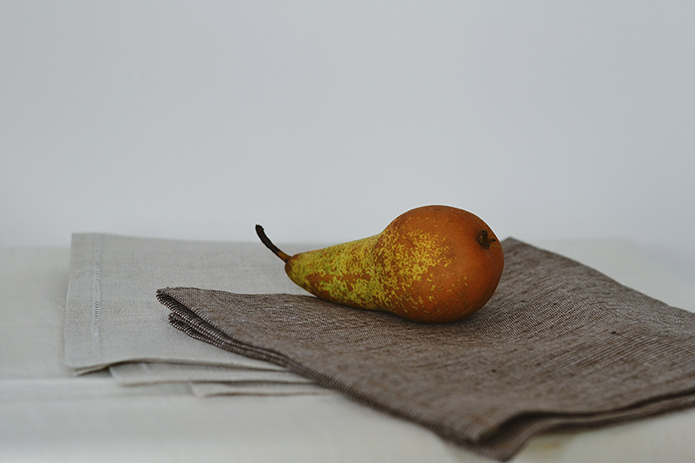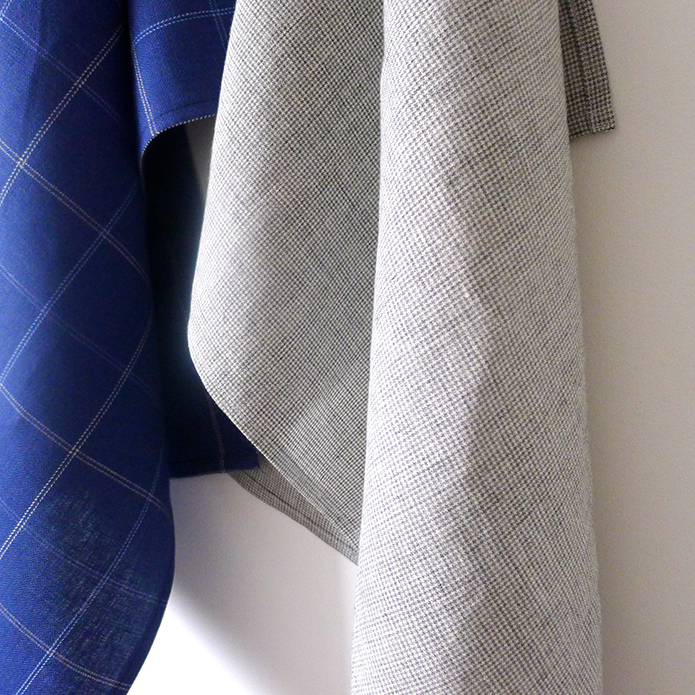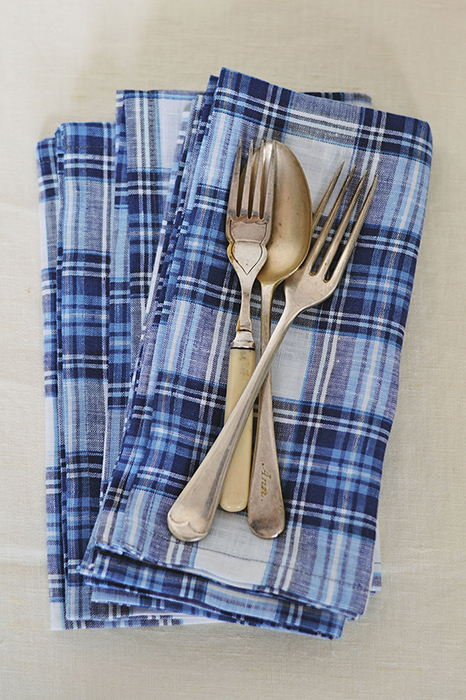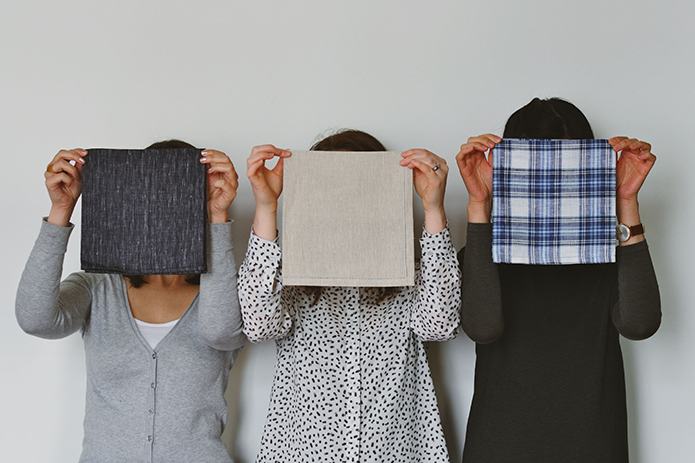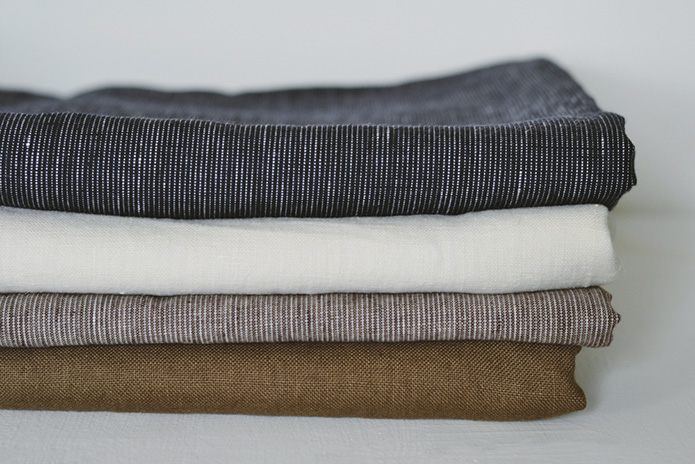
Irish linen by 31 Chapel Lane © 31 Chapel Lane
Linen has always been recognised as the strongest natural fibre, even more so wet, and therefore it made perfect sense that the sails of the famous tea-bearing clipper ships, the Cutty Sark being the most famous example, were made of flax linen. The moisture absorbing properties of linen make it an excellent drying material; back to tea, the best performing tea-cloths are always linen. And on a more intimate note, linen bedding is considered by many to be the healthiest fabric to have next to your skin when sleeping, being non-allergic, antibacterial, antimycotic and anti-static; retaining body heat in the cold, whilst absorbing heat and moisture in hot weather.
Irish linen is an iconic and traditional textile, spun into yarn, and woven into cloth, from the fibre of the flax plant, which was grown historically throughout Ireland over the centuries, due to the damp bogginess of over half the country, favouring its cultivation. As well as this, the processing of the flax fibre, the spinning of the yarn and the weaving of the linen cloth, is complemented by the humid environment Ireland experiences – this is a polite way, in other words, of saying WET – as the colder northern airs above Ireland react with the warm, moisture laden air brought in by the Gulf Stream from the equator, creating copious amounts of mist and rain, watering the Isle until it is, indeed, emerald with vegetation. The Irish water is also significant in the washing of the yarn and during the dyeing process, as the softness of the water seems to magically enhance the quality of the linen.
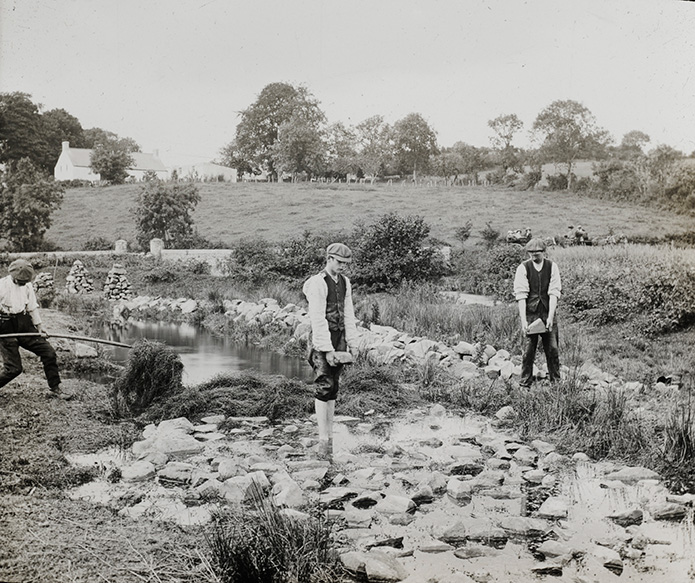
Putting flax to ret in the dam. Retting is the process of separating the flax fibres from the rest of the stalk; the first step is to rot away the inner stalk from the outer fibres which remain intact. Image courtesy of National Museums Northern Ireland. Ref: BELUM.Y13303. Collection Ulster Museum.
One such moist Irish linen producing area has been Cootehill, especially in the 18th Century and later parts of the 19th Century, when the quality of Irish linen was recognised all over the world, and the cloth of choice up until the early 20th Century. Irish linen meets all green credentials as it is truly natural; sustainably grown and processed, preferable, at the very least, in today’s more environmentally conscientious climate.
31 CHAPEL LANE
31 Chapel Lane, from Cavan, is a simply sophisticated and sophisticatedly simple Irish linen business which seeks to promote and nurture the manufacture of Irish linen, as a fundamental part of Irish history, both past and present. Co-founders; Irishman Damien Hannigan and partner Joy Fu, from Australia, happened upon the historical relevance of the linen industry in the Cootehill area. As a committed and passionate, albeit small team, they have transplanted the seed of heritage into a present day cottage industry to create a unique take on contemporary Irish linen, beyond doylies and table runners, one which celebrates the natural raw strength and beauty that demarcates the cloth from mass-produced anonymous imitations from Eastern Europe, India and China that have usurped Irish linen in the name of economy, but not quality.
Here, we talk to Damien and Joy about Irish linen; its history, its stumbles and falls and, thankfully, its recent revival in their safe hands, and its poignant place within the welcome return of responsible and discerning consumption.
Firstly, for those readers that aren’t familiar with Irish Linen, please can you describe what it is and how it differs to other forms of linen?
Irish linen is known the world over for its unparalleled quality. A characteristic earned and developed over centuries and one born from a culmination of factors. Geographically speaking the wet, humid climate in Ireland, and more specifically Northern Ireland, is naturally conducive to the growth of flax.
Add to this the fact that when the industrial production of linen began here in earnest in the 17th Century the most knowledgeable and skilled of specialists were sought and brought from Belgium to advise on the mechanics of the industry and a means of improving efficiency perfected.
Equally the relatively low wages being paid to Irish workers kept costs down and demand high. This ensured that Ireland became the dominant force in linen production worldwide and by virtue of the sheer quantities being we produced we became the best at producing.
In short, practice made perfect. Although the industry has been in decline for the last century those skills and techniques accrued and perfected over hundreds of years remain at the heart of our linen production today.
Can you explain how Irish linen has developed throughout history, to the point it is at today?
The first definite mention of linen production as a trade appeared in the 13th Century, apparently flourishing under the watchful eye of the Irish abbeys and the philanthropic monks of the day.
By the 16th century linen was abundant and ubiquitous as a form of clothing. Shirts containing thirteen or fourteen yards of the fabric would have been common for example. But despite its apparent prevalence the linen trade in Ireland was still no more than a ‘cottage’ industry with many families producing small quantities to supplement their primary agricultural income.
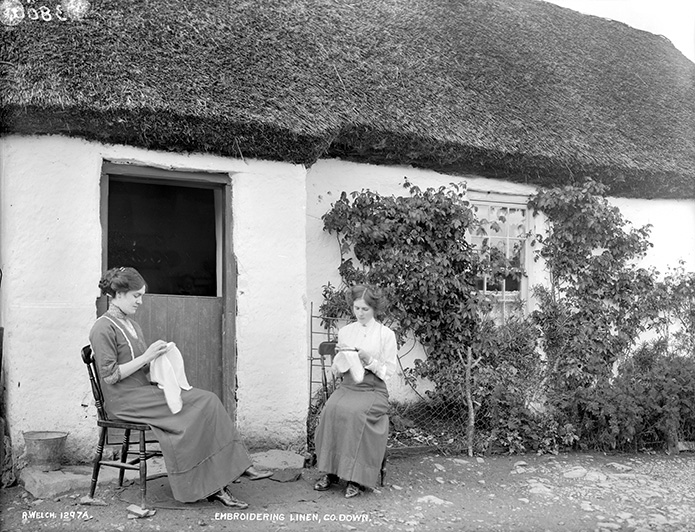
Two girls embroidering linen outside the door of their thatched house, County Down. Image courtesy of National Museums Northern Ireland. Ref: BELUM.Y.W.05.99.22. Collection Ulster Museum.
The first steps toward the production of linen on an industrial scale probably started in the 17th century. In a contradiction of sorts it was prompted by the successes of the Irish wool weavers at the time. The British woollen industry was under intense pressure from its Irish counterparts and introduced a series of measures to obstruct this growing competition.
Anti-competitive taxes and duties on were placed on Irish woollen exports while the growth of flax was aggressively promoted throughout the northern counties. Flax seed was regularly sold at cost price to Irish tenant farmers for example. Specialists from Belgium were enlisted to advise on and implement standardised linen manufacturing systems throughout the existing network of weavers. These systems placed considerable emphasis on quality control and consistency in the linen production.
The new Irish textile industry grew to become the sole economic trade in many parts of the country and by the 18th century every town and village in Northern Ireland had a mill or factory for the production of Irish linen.
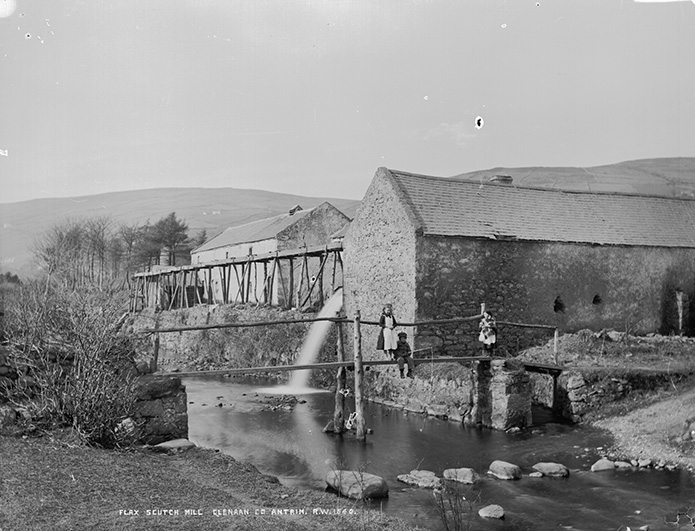
Scutch mill at Lubitavish, County Antrim. Scutching is the process of dressing flax in preparation for spinning, such as removing straw and woody stem from flax fibres. Image courtesy of National Museums Northern Ireland. Ref: BELUM.Y.W.01.54.28. Collection Ulster Museum.
In the 19th century power-driven manufacturing machinery began to appear and very rapidly became a requirement for any serious mill. Industrialisation, as we know the term today, occurred and the centuries old cottage industry was wiped out. The scale of manufacture was altered completely and a continuous striving for improvements to efficiency established Irish linen as the best in the world.
This period was influential beyond the confines of the textile industry. It formed our towns and landscapes as street and areas adopted names associated with the linen or it’s production. One such example is at my family’s farm outside Cootehill, Co. Cavan. Hannigans have worked this land for over a century and for at least three generations it’s been principally a dairy farm. Yet even today we refer to one particular paddock as the “Flax –hole field”. A term which meant little to us prior to 31 Chapel Lane.
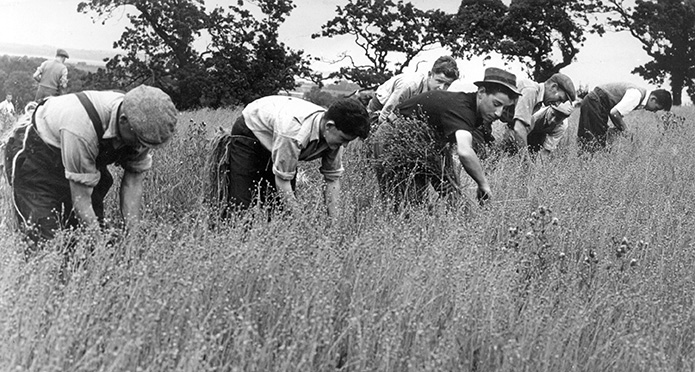
Flax harvesting 1957. Image courtesy of Belfast Telegraph. In its hey-day flax harvesting was a tedious, back-breaking and labour-intensive chore, as this flashback to the 50’s shows.
It’s also worth noting the huge growth of the linen trade was offset by the decline of our other textile industries. In the late 19th century, for example, the American Civil War diminished their export of cotton and this practically destroyed the Irish cotton industry, which relied on the U.S.A. for its raw material.
Linen was used extensively during World Wars I & II in the manufacture of RAF and Royal Navy supplies. Subsequently the supply of linen to civilians decreased and with that it attained a marque of exclusivity. Irish linen was suddenly unattainable to an entire generation; its beauty and quality were no longer the daily standards. We personally feel that this altered perception was never remedied and unfortunately by the end of the 20th century, the industry had shrunk to just a handful of mills.
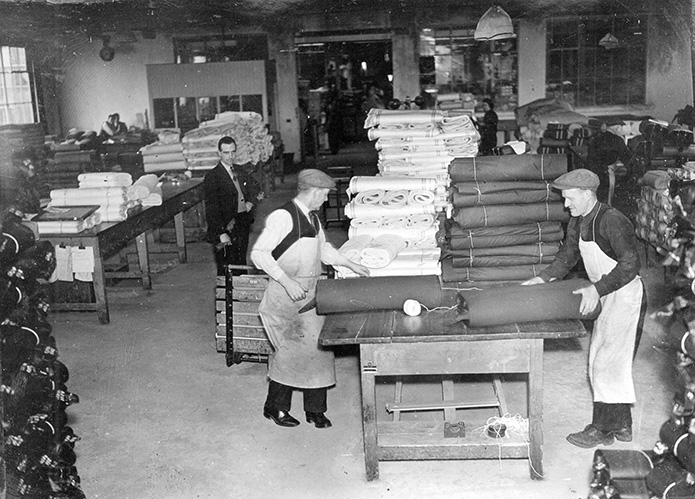
Staff at Wm Clark and Sons Ltd, Upperlands, Co. Derry, lapping up cloth for Navy Wrens uniforms, 1944. Image courtesy of Belfast Telegraph.
To the touch, how does Irish Linen differ to other forms of fabric?
The special and attractive properties of Irish linen are:
(1) In its purified, bleached form the flax fibre is largely pure cellulose with a smooth, highly lustrous surface. It is hygroscopic, that is, it is sensitive to moisture, and absorbs up to one-fifth of its own oven-dry weight of water without being damp on the surface. The personal importance of this quality is evident when one thinks of clothing worn next to the skin.
(2) Bleached linen absorbs water from a wet surface very rapidly and it is smooth, without loose, protruding hairs. This is why flax is by far and away the ideal fibre for making towels of all kinds, glass cloths and handkerchiefs.
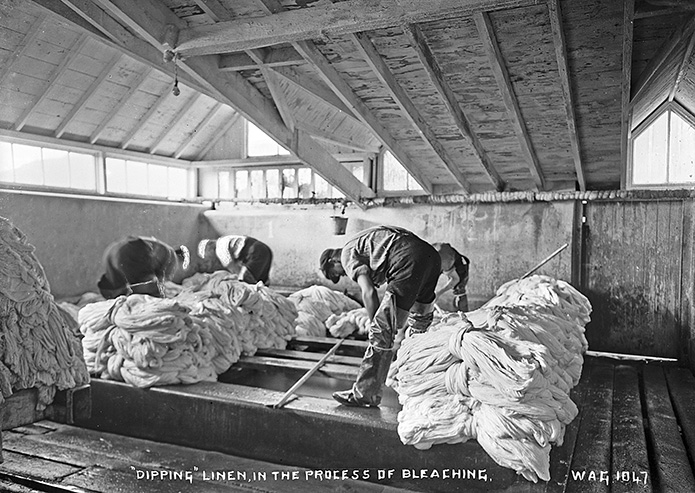
An interior view in a spinning mill of men dipping linen into troughs in the process of bleaching. Image courtesy of National Museums Northern Ireland. Ref: HOYFM.WAG.1047. Collection Ulster Folk & Transport Museum.
(3) Unlike most textiles, flax yarns and fabrics increase about one-fifth in strength on wetting … a fact that is of considerable importance for cloths that have to undergo repeated launderings, particularly in the washing machine age.
(4) Linen fibres swell when wet. In suitably designed fabrics, such as tents, tarpaulins and hose-pipes, the interspaces can be completely closed up to prevent the passage of water; in other words, to make them practically waterproof.
(5) Linen fabrics have the highest resistance to tearing because flax is the strongest natural fibre.
What constitutes ‘true’ Irish linen – does it have to be woven in Ireland, or can it be simply finished in Ireland, and woven elsewhere?
Genuine Irish linen as defined by the Irish Linen Guild – “To be Irish linen fabric the yarns do not necessarily have to come from an Irish spinner, and to be Irish linen yarn the flax fibre does not have to be grown in Ireland. However, the skills, craftsmanship, and technology that go into spinning the yarn must be Irish, as is the case with Irish linen fabric, the design and weaving skills must be Irish, and must take place in Ireland.”
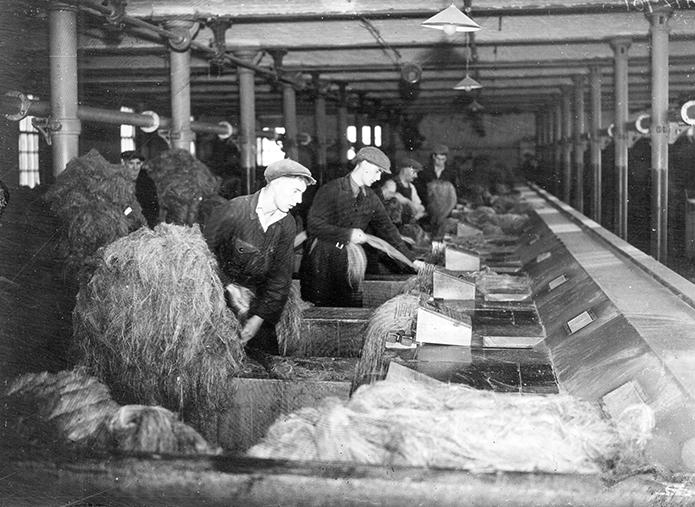
Braidwater spinning at Ballymena, 1945. The first stage in spinning is to rough the flax. Image courtesy of Belfast Telegraph.
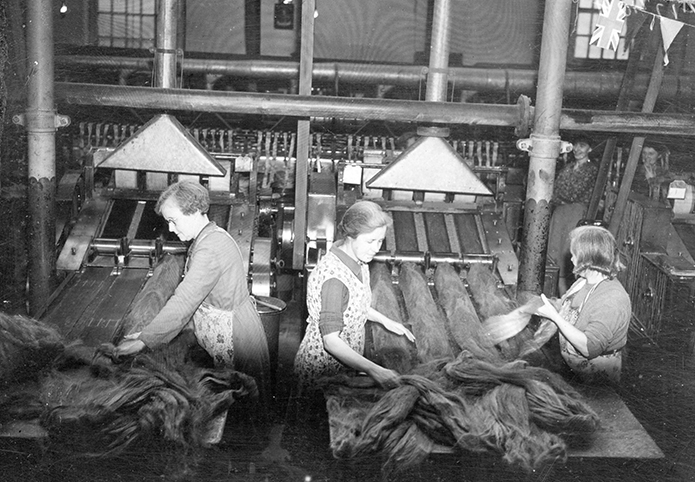
Braidwater spinning at Ballymena, 1945. These workers are spreading ‘tow’, some of the finer fibres separated from the straw in the heckling process, where straw is removed from the fibres. Image courtesy of Belfast Telegraph.
In England, Lancashire is an area renowned for its cotton production. Are there any areas, aside from Cootehill, that are particularly noted for its Irish linen production, and why?
Northern Ireland has always been a stronghold for the production of linen. As mentioned earlier this may have its basis in geographic and climatic motives but was perpetuated politically.
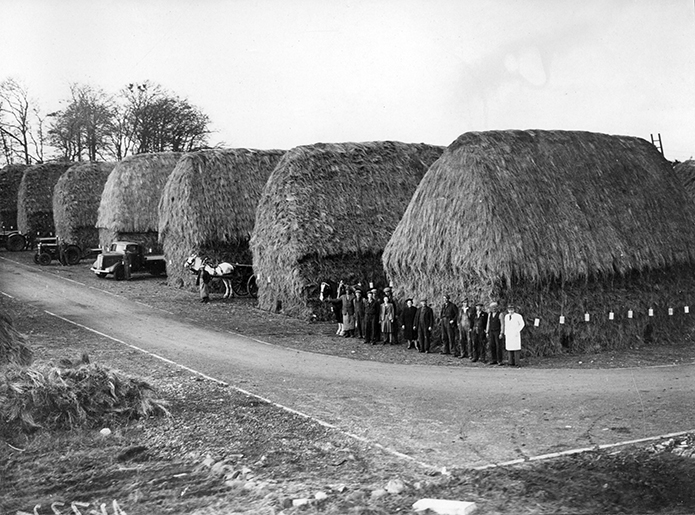
Flax stacks at Ministry of Supply factory, Mossley Mill, County Antrim, 1942. Image courtesy of Belfast Telegraph.
Are there any items or garments that were traditionally made from Irish linen, and are any of these items still popular today, either domestically in Ireland, or overseas?
Before its 20th Century ascent into fabric aristocracy linen was readily available, abundant even, so it would have been used for many day-to-day items. The shirts and chemises from the 16th century mentioned above each contained huge quantities of the fabric linen. Bed linens, tablecloths, upholstery, even bath towels. Linen is extremely versatile.
In your opinion, how will the pressure from cheap linen imports from abroad affect the Irish linen industry going forwards, and do you feel it will remain a distinctive brand in future generations?
There will always be debate around value and cost and it’s important to recognise that Irish linen was once “a cheap import”. But through that period it accrued an invaluable advantage in the form of time and experience. The cloth produced here is now second to none in terms of quality and as long as that tradition of consistency and continuous improvement is maintained then Ireland will remain a distinctive brand.
What was it about Irish linen that inspired you to establish 31 Chapel Lane in the first place?
Throughout linen’s lifetime it has an intrinsic bond with water. The flax plant grows best in a humid climate and moist soil. The very first process in the production of the linen fibres is the soaking of the harvested flax in pools of water thus rotting away the stem bark to access the fibres.
This association with water and moisture continues over time as linens are repeatedly washed. It’s this relationship that means the linen develops continuously over time. It’s quite charming to think that the linen fabric you buy has not yet reached its finished state.
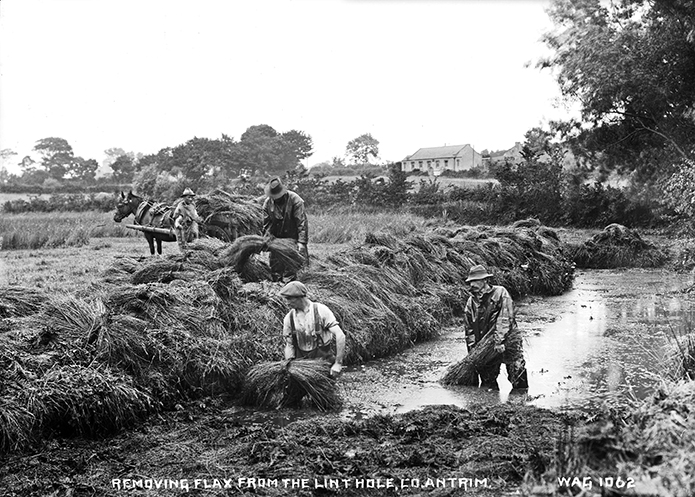
A view of two men wading in the lint hole and removing flax to two others with a horse and cart, Cloney Farm, Knocknacarry, County Antrim, c1914. Lint (flax) would be soaked in water, in a man-made dam or water hole (a process known as retting), to partially rot the outer fibres of the flax stems, in order for the fibres to be separate from the straw stalk for spinning into flax thread. Image courtesy of National Museums Northern Ireland. Ref: HOYFM.WAG.1062. Collection Ulster Folk & Transport Museum.
In our approach to the things we make we have one rule – that is to provide Irish linen, an inherently beautiful fabric, in as raw a state as possible to our customers. This sometimes means that certain items are extremely limited as we simply found a beautiful piece of cloth that we ourselves would like to have in our home in one form or another. We think ourselves very lucky to work with such a material and coming up with new ways to work to its strengths is a constant joy.
In choosing to use Irish fabrics in all our products we have made quality our goal. The cost of production in Ireland means that we simply cannot compete with mass produced items. By making small batches of our designs we ensure that we have complete control over the design and quality of finish. We’ve fretted over stitch technique on more than one occasion. This is both a burden and a blessing.
We are huge fans of seasons, changing weather, semesters, that kind of thing. We feel that Seasonal Collections are important milestones for our work. They provide us with beginnings and ends. It’s very important to complete something. The act of pulling together these collections has out grown the confines of our studio. We travel for fabrics or inspiration and all of this can become time consuming, it can be difficult to give each pursuit the time it deserves. Especially since 31 Chapel Lane is not yet at a stage where it can be our sole pursuit.
You decided to focus on contemporary designs for your Irish linen products rather than traditional; why was that and can you talk through some of the inspiration for your products?
Inspiration might be stories and experiences of people and places, our own needs, a particular piece of cloth we have found. Taking tea cloths as an example. They are a must in every household. They are functional and practical yet at the same time their appearance and feel can contribute and add character to any kitchen. They accent.
Our approach to living space and home interiors is one of simplicity or just enough. Items should serve a practical purpose first and foremost and complement rather than outdo one another.
The simplicity of our products is probably a by-product of how we work rather than an explicit aesthetic decision. We really want to highlight the cloth, we want to celebrate the raw material as much as possible and we want our customers to associate “Made in Ireland” with the natural qualities of the product, not the patterns or imagery applied in the final stages of production.
Finally, what does the future hold for 31 Chapel Lane?
Irish Linen has a very strong reputation worldwide. It’s used by so many of the top designers and fashion houses throughout Europe and America but there is a definite disparity in what the day to day consumer perceives to be Irish linen and what these international designers and value it for. We think this fairly symptomatic of many things that are made here. There is a pressure, perhaps a need to stamp it with “Irishness”. We ourselves struggle with this also.
We would like to think that the future of Irish linen is a general de-clutter. Less self consciously “Irish” and a greater focus on the quality of the cloth itself.
We do not believe we have ever had the pleasure of using the word ‘bastion’ before and unfortunately it seems a little strong for our current position. We would say that we are very carefully finding our feet in this industry and we would like to learn to walk before we run.
Financial limitations mean that we are not always in a position to do exactly as we would like, be that increased quantities of a certain product or just expanding the range of products. These problems are obviously not unique to us but we are forever mindful of the fact and so the restrictions just become our parameters.
It has been our decision to design and promote Irish made products in a non-traditional manner that has meant that factories have been, understandably, hesitant to alter their machines for our products. This simply means that we make them ourselves. This obviously has its pros & cons. Apart from anything else we have been able to meet a lot of really impressive people and see parts of Ireland that I had rather stupidly neglected until now. From a design point of view we see collaboration as a great means of developing our own ideas and improving our technical skills quickly.
As a company we want to grow. We’re currently looking at different methods of doing so and the ultimate goal is to create employment in Ireland. I think it would be quite fitting to achieve this through the linen industry.
Many thanks to Damian and Joy for taking time out of their busy schedule to answer our questions.

